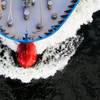EPA Releases Toxicity Testing Data for Eight Oil Dispersants
The US Environmental Protection Agency (EPA) released peer reviewed results from the first round of its own independent toxicity testing on eight oil dispersants. EPA conducted testing to ensure that decisions about ongoing dispersant use in the Gulf of Mexico continue to be grounded in the best available science. EPA’s results indicated that none of the eight dispersants tested, including the product in use in the Gulf, displayed biologically significant endocrine disrupting activity. While the dispersant products alone – not mixed with oil - have roughly the same impact on aquatic life, JD-2000 and Corexit 9500 were generally less toxic to small fish and JD-2000 and SAF-RON GOLD were least toxic to mysid shrimp. While this is important information to have, additional testing is needed to further inform the use of dispersants. "EPA is performing independent tests to determine the potential impacts of various dispersants. We will continue to conduct additional research before providing a final recommendation, " said EPA Administrator Lisa P. Jackson. "We want to ensure that every tool is available to mitigate the impact of the BP spill and protect our fragile wetlands. But we continue to direct BP to use dispersants responsibly and in as limited an amount as possible."
EPA continues to carefully monitor BP’s use of dispersant in the Gulf. Dispersants are generally less toxic than oil and can prevent some oil from impacting sensitive areas along the Gulf Coast. EPA believes BP should use as little dispersant as necessary and, on May 23, Administrator Jackson and then-Federal On-Scene Coordinator Rear Admiral Mary Landry directed BP to reduce dispersant usage by 75 percent from peak usage. EPA and the Coast Guard formalized that order in a directive to BP on May 26. Over the next month BP reduced dispersant use 68 percent from that peak.












